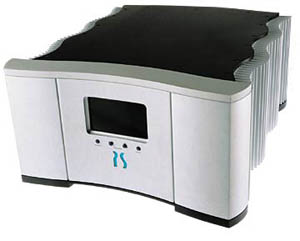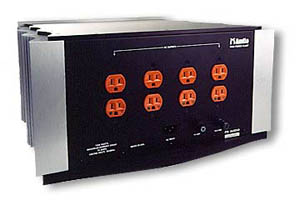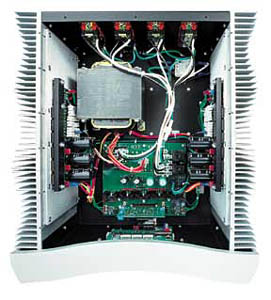![[SoundStage!]](../titles/sslogo3.gif) Home
Audio Home
Audio Equipment Review |
||||||||||||||||||||||||
Many consider AC-line treatments a mandatory part of a high-resolution audio/video system. There is also a small but vocal contingent that considers them nothing but snake oil, marketed and manufactured to take advantage of gullible audiophiles. Whether you consider yourself a member of the later or the former may depend on a couple of things. First, for a small (and very lucky) number of audiophiles, these treatments may make no difference to the sound of their systems. This is probably because these audiophiles' listening rooms are located in the middle of nowhere (or they can see it from where they live). The power supplied to the home, one of only a few in the area, is likely as close to pure as possible. Alternatively, and unfortunately for the majority of the rest of us, our listening rooms are located in a populated area where the power is likely to be anything but pure. A positive difference in sound when using a power-line treatment will likely be heard. I’m afraid I’m one of the unlucky ones who live in an area that's not the best for good sound. Although those living in an urban high-rise might be worse off than what I have to deal with as far as AC power is concerned, the juice supplied to my home is pretty bad. I’m one mile outside of a major metropolitan area and in a very populous suburb. There are many broadcast towers, some closer than a half mile away, one being used by a 50,000-watt FM station. Overhead lines on telephone poles carry cable TV, electrical power, telephone, and who knows what else. Retail, industry, and large apartment complexes are close by, and the subway station is blocks away. During the day, and especially during the summer months, it seems like my system’s sound is degraded to the fidelity of a portable AM radio. At night things get better, but only after 9:00 PM does the system reach what I used to think was its full potential. I tried power conditioners -- from Chang Lightspeed, Tice, MIT, Blue Circle, and many others. The ones that worked best in my system were those from MIT and Chang. These definitely made a difference -- but there was still a noticeable difference between the sound of the system in the day and at night. I investigated other options, including generators, battery power, and some other large transformer installations. All were prohibitively expensive -- and none were guaranteed to work. Last year I was doubly blessed. In October our daughter was born -- my toothless angel. About the same time, PS Audio introduced the first model of their Power Plant line, the P300. This is not a power condition like the models I previously auditioned, but a power regenerator that synthesizes pure AC power. Although it only had enough power capacity to handle the front-end of my system, at last my system was becoming more listenable. With our daughter now sharing our residence, my late-night listening sessions had to be performed during the daylight hours. This was only made possible when using the Power Plant P300. Yet there was still that last bit of frequency extension, smoothness, and detail missing that were only present at night. The only way I was going to get this resolution was by supplying pure AC to the entire system, including the power amp. PS Audio answered my prayers with the introduction of the P600. Finally. How does it work?
With everything connected to the P600 Power Plant, the total current requirements of all units combined cannot exceed 720 watts. The P600 is capable of up to 1000 watts for brief periods of time, allowing you to connect reasonably large power amps. I connected all my equipment, other than the powered subwoofer, with no problems whatsoever. Use
But by any reasonable standards, the Power Plant P600 is heavy and huge. It weighs 90 pounds (the 220-volt model weighs 15 more), is 17"W, 9"H, and 19.4" D. I had quite a time unpacking the unit, lugging it across the listening room, and positioning it in an adequate location. Again, it didn’t generate all that much heat -- I left it powered 24 hours a day and it never became more than very warm to the touch. I tried to give it as much breathing room as possible, although it wasn’t as much of a concern as with the space-heater-like character of the P300. I connected every piece of my two-channel system to the P600. Even though the manual states that the P600 shouldn’t be used for power amps greater than 200Wpc, PS Audio assured me that the 250Wpc Krell KAV-250 I own should pose no problem. I connected the sub for just a short time, but the noise coming from its internal amp let me know that this wasn’t such a good idea, so instead I hooked it up to a Chang Lightspeed power conditioner. The front panel of the P600 has four push-button switches: Power, Mode, select up, and select down. There is also a master power switch on the rear panel that I rarely used. The mode switch activates the front-panel display, which indicates the number of watts produced by the Power Plant. Because the select up/down switches control its use, it’s important that I discuss the MultiWave option of the Power Plant. But calling this function an "option," to me, is a misnomer. The MultiWave function improves the sound to such a degree that I couldn’t imagine buying the P600 without it. Basically, instead of using a single sinewave, MultiWave uses simultaneous multiple waveforms to feed a power supply. So besides choosing between the 20 frequency settings of the single sinewave, the select up/down buttons choose between ten types of MultiWave patterns. PS Audio has positioned each MultiWave waveform on the menu according to the company's belief in its effectiveness -- the one that PS Audio believes to be the best is first, the second best is second, and so on. I found that the first and fifth sounded the best, and some selected made the sound worse -- but none was as bad as using no Power Plant at all! And almost all sounded better than the non-MultiWave setting.
Even with the MultiWave option installed, you can still use the standard single waveform. The select up/down switches will choose which frequency, in 20 steps from 50Hz to 120Hz the Power Plant will generate rather than the 60Hz (or 50Hz foreign) the wall current generates. Some of these frequencies will work better than others at powering different types of equipment, and there are sonic tradeoffs that have to be made with each frequency chosen. Some improved the treble but sacrificed midrange clarity; some improved the mids, some the bass. I found a frequency of 90Hz the best overall, but your mileage may vary. Another nice feature of the MultiWave upgrade is the ability to alter the voltage that is supplied to the equipment. Although I ended up using the standard 117 VAC, I tried a voltage as high as 121 VAC with varying results. The "sound" I hesitate calling what the Power Plant did to my system as imparting a particular sound. When I investigated different standard power conditioners, I found that all improved the sound of the system in one way or another, but all had a certain personality. One unit would make the system sound brighter than the other would; one would impart a burnished character, while another would make the bass sound a bit thick. And none of them would allay the problem I had of the system sounding better at night than in the daytime. But the Power Plant P600 changed this. It just made my entire system sound better and brought out the best in each of the components it powered. When switching components for review or other types of experimentation, their individual characteristics were much more pronounced when using the P600. That’s it. I could waste some serious space writing about the system’s increased frequency extension, deeper and wider soundstage, better low-level retrieval, and more natural sound. But what I first noticed with the Power Plant P600 in the system was the complete lack of any background noise -- grounding problems were a thing of the past too. There was no more need to lift grounds or perform any other types of fixes. Plus, I’m lucky that my turntable uses a DC motor, so I was also able to power it with the P600. From that point on, the ground connection didn’t make much of a sonic difference -- whether it was attached to the preamp or not. Across-the-board improvements were evident in my entire system, and discussing each would only turn this review into a primer on audiophile sound. Should I cite specific musical examples? That, too, would be a waste of time, for the choice of program material mattered not at all. The Power Plant P600 improved every sonic parameter. And the difference between how the system sounded in the daytime versus at night? None that I could perceive, and probably none that could be measured either. Because the pure AC generated was just that, it did not vary, regardless of the time of day or what equipment was plugged into the P600 or what type of music I played.
Comparisons Comparisons to what? I already touched upon the inability of standard power conditioners to "repair" faulty AC provided by the electric company. Yes, they can filter the electricity and perform other ways to clean up the filthy current supplied. But they don’t correct voltage dips or surges. They can protect your valuable electronics against the deleterious effects of these anomalies, but correct these anomalies? Forget it. And forget about changing the frequency of the power. I guess if I did install some sort of battery or power generator in my home, I could compare it to them, but… Some very expensive gear uses the type of power supplies that achieve what the Power Plant does to the AC; that is, they convert to DC and back to pure AC before going to the component’s main power supply. But I did not have any of that equipment on hand to try, and I don’t know if I ever will. Suffice to say the Power Plant P600 is the best audio accessory I’ve ever had in my system -- although it is an accessory in my system no longer, but rather an integral part of the entire chain that I can no longer do without. Problems? The only problems I encountered with the P600 were probably caused by me using a power amp slightly above the recommended maximum power. When turning on the power to the amp the surge would cause the preamp to go into stand-by mode. But this wasn't difficult to prevent -- I simply turned on the power to the amp before that to the preamp, and the preamp’s protective standby circuit, which is activated for about a minute, prevented any "thud" from coming through the speakers. Also, I once turned on the Power Plant with the power switches to the connected components in their "on" positions. This caused the P600 to shut down. After about a half-hour rest with its power cord removed, I re-powered the P600 (with the equipment off!) and it operated perfectly. I used some equipment that didn’t have a power switch, such as a DAC and headphone amp. They drew so little power that it didn’t seem to matter if the Power Plant was powered up with those units already on. But in regular use, I left the P600 powered continuously. The preamp is left in standby mode when it is not operating to prolong its tube life, and the P600 never complained. Conclusion Some may balk at the price of P600, but I can't imagine any audiophiles being anything but pleased with the sonic results -- unless they live in ideally powered homes that most of us can only dream of. I guess the P600's other negative is its enormity, which also becomes a moot point when its inconvenience is weighed against the improvement in sound it effects. Short of nominating the folks at PS Audio for a Nobel Prize, I declare the P600 as the single most impressive piece of equipment that has passed through my system. I could say that the improvement to the sound of the system was as if I upgraded a component to one costing twice as much money, but the P600 did so much more than that. My system could hardly be considered to be the most opulent, so perhaps the P600's effects won’t be as noticeable in a higher-resolution system -- or perhaps would it make an even more noticeable difference. I would surely give the Power Plant P600 a try, though, because even with my power problems, I am happy at last. ...Tom Lyle
|
||||||||||||||||||||||||
|
||||||||||||||||||||||||
![[SoundStage!]](../titles/sslogo3.gif) All
Contents All
ContentsCopyright © 2001 SoundStage! All Rights Reserved |


 For a much more complete
technical explanation of how the Power Plant does the voodoo it does, I suggest visiting
PS Audio’s website or reading the
For a much more complete
technical explanation of how the Power Plant does the voodoo it does, I suggest visiting
PS Audio’s website or reading the  Most complaints
regarding the P300, the P600’s older sibling, were the heat the unit generated and
its odd shape. The P300 is not very wide, but at 20.5" long, it is deeper than many
racks. Plus the heat it generates prevents it from being placed on most racks anyway
because the shelves would have to be spaced far apart enough for sufficient ventilation.
The P600 doesn’t generate nearly as much heat because the much larger sides are
basically the unit’s heat sinks.
Most complaints
regarding the P300, the P600’s older sibling, were the heat the unit generated and
its odd shape. The P300 is not very wide, but at 20.5" long, it is deeper than many
racks. Plus the heat it generates prevents it from being placed on most racks anyway
because the shelves would have to be spaced far apart enough for sufficient ventilation.
The P600 doesn’t generate nearly as much heat because the much larger sides are
basically the unit’s heat sinks.